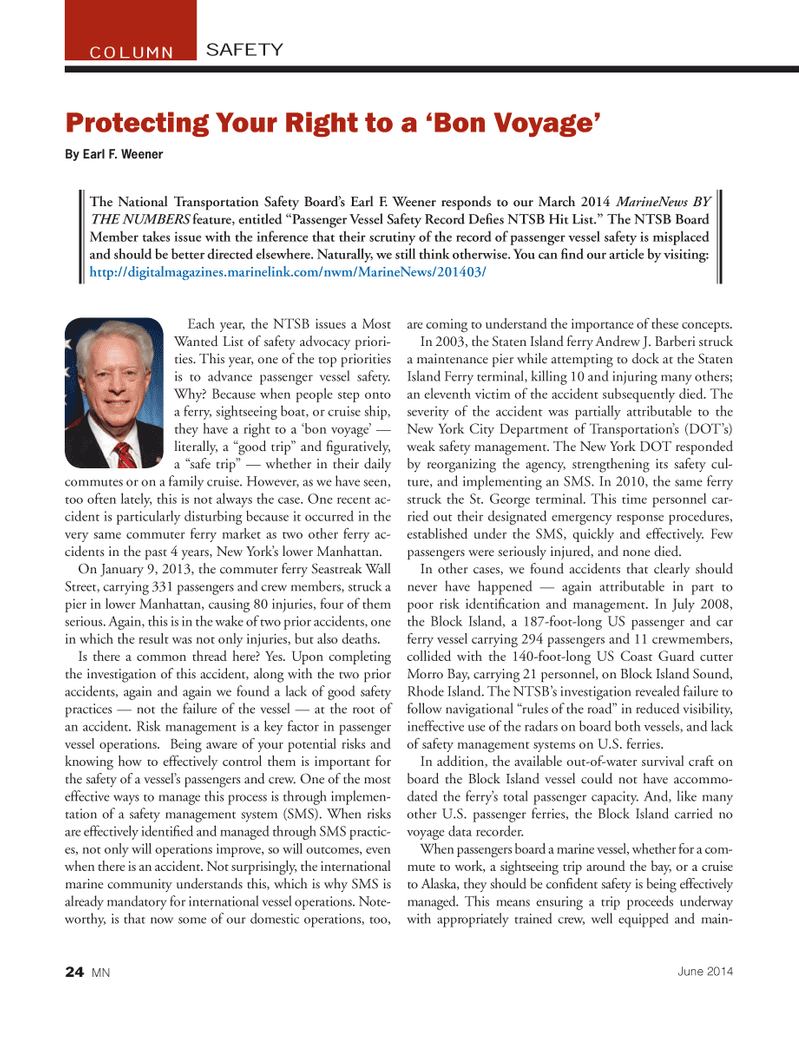
Page 24: of Marine News Magazine (June 2014)
Dredging & Marine Construction
Read this page in Pdf, Flash or Html5 edition of June 2014 Marine News Magazine
Each year, the NTSB issues a Most Wanted List of safety advocacy priori- ties. This year, one of the top priorities is to advance passenger vessel safety. Why? Because when people step onto a ferry, sightseeing boat, or cruise ship, they have a right to a ?bon voyage? ? literally, a ?good trip? and guratively, a ?safe trip? ? whether in their daily commutes or on a family cruise. However, as we have seen, too often lately, this is not always the case. One recent ac- cident is particularly disturbing because it occurred in the very same commuter ferry market as two other ferry ac- cidents in the past 4 years, New York?s lower Manhattan. On January 9, 2013, the commuter ferry Seastreak Wall Street, carrying 331 passengers and crew members, struck a pier in lower Manhattan, causing 80 injuries, four of them serious. Again, this is in the wake of two prior accidents, one in which the result was not only injuries, but also deaths. Is there a common thread here? Yes. Upon completing the investigation of this accident, along with the two prior accidents, again and again we found a lack of good safety practices ? not the failure of the vessel ? at the root of an accident. Risk management is a key factor in passenger vessel operations. Being aware of your potential risks and knowing how to effectively control them is important for the safety of a vessel?s passengers and crew. One of the most effective ways to manage this process is through implemen- tation of a safety management system (SMS). When risks are effectively identi ed and managed through SMS practic- es, not only will operations improve, so will outcomes, even when there is an accident. Not surprisingly, the international marine community understands this, which is why SMS is already mandatory for international vessel operations. Note- worthy, is that now some of our domestic operations, too, are coming to understand the importance of these concepts. In 2003, the Staten Island ferry Andrew J. Barberi struck a maintenance pier while attempting to dock at the Staten Island Ferry terminal, killing 10 and injuring many others; an eleventh victim of the accident subsequently died. The severity of the accident was partially attributable to the New York City Department of Transportation?s (DOT?s) weak safety management. The New York DOT responded by reorganizing the agency, strengthening its safety cul- ture, and implementing an SMS. In 2010, the same ferry struck the St. George terminal. This time personnel car- ried out their designated emergency response procedures, established under the SMS, quickly and effectively. Few passengers were seriously injured, and none died. In other cases, we found accidents that clearly should never have happened ? again attributable in part to poor risk identi cation and management. In July 2008, the Block Island, a 187-foot-long US passenger and car ferry vessel carrying 294 passengers and 11 crewmembers, collided with the 140-foot-long US Coast Guard cutter Morro Bay, carrying 21 personnel, on Block Island Sound, Rhode Island. The NTSB?s investigation revealed failure to follow navigational ?rules of the road? in reduced visibility, ineffective use of the radars on board both vessels, and lack of safety management systems on U.S. ferries. In addition, the available out-of-water survival craft on board the Block Island vessel could not have accommo- dated the ferry?s total passenger capacity. And, like many other U.S. passenger ferries, the Block Island carried no voyage data recorder. When passengers board a marine vessel, whether for a com- mute to work, a sightseeing trip around the bay, or a cruise to Alaska, they should be con dent safety is being effectively managed. This means ensuring a trip proceeds underway with appropriately trained crew, well equipped and main- SAFETYCOLUMNProtecting Your Right to a ?Bon Voyage? By Earl F. Weener The National Transportation Safety Board?s Earl F. Weener responds to our March 2014 MarineNews BY THE NUMBERS feature, entitled ?Passenger Vessel Safety Record De es NTSB Hit List.? The NTSB Board Member takes issue with the inference that their scrutiny of the record of passenger vessel safety is misplaced and should be better directed elsewhere. Naturally, we still think otherwise. You can nd our article by visiting: http://digitalmagazines.marinelink.com/nwm/MarineNews/201403/ June 201424 MNMN June14 Layout 18-31.indd 24MN June14 Layout 18-31.indd 245/20/2014 10:31:20 AM5/20/2014 10:31:20 AM

 23
23

 25
25
